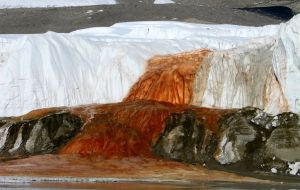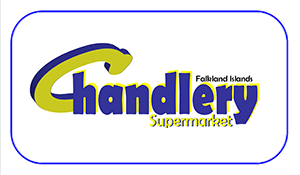MercoPress. South Atlantic News Agency
Antarctica Blood Falls could be connected to subsurface lakes system
 “I’ve been studying Blood Falls for quite some time, and it’s always been a mystery,” said lead study author Jill Mikucki of the University of Tennessee.
“I’ve been studying Blood Falls for quite some time, and it’s always been a mystery,” said lead study author Jill Mikucki of the University of Tennessee.  The subsurface ecosystems of extreme microbes might be connected to visible lakes, and perhaps even interact with the ocean.
The subsurface ecosystems of extreme microbes might be connected to visible lakes, and perhaps even interact with the ocean. The McMurdo Dry Valleys of Antarctica are some of the most extreme desert regions on the planet. But new research indicates that the region may actually be full of salty, extremely cold groundwater. The water may even connect surrounding lakes into a massive network, and it probably hosts extreme microbial life.
The findings were reported this week in Nature Communications.
Despite McMurdo’s apparent dryness on the surface, it’s always hinted at something more: the region is home to the magnificently creepy Blood Falls, a red ooze that shines bright against the otherwise desolate surface.
For a while scientists believed that red algae gave this mysterious, bloody ooze its vibrant color. But even though iron oxide is responsible for the hue, analysis has shown that the feature does contain strange bacterial life.
Scientists knew that ooze had to be coming up from somewhere, but were surprised to find just how extensive the valley’s briny waterways might be.
“I’ve been studying Blood Falls for quite some time, and it’s always been a mystery,” said lead study author Jill Mikucki of the University of Tennessee. As a microbiologist, she’s long been interested in the communities that live in the oozy brine.
She and her colleagues used an electromagnetic sensor mounted on a helicopter to scope out the area, testing the conductivity of the ground below. Water increases its resistivity as it freezes, meaning that it’s less conductive of electrical currents. But salty water – which can stay liquid at lower temperatures – have very low resistivity.
“We found, as expected, that there was something sourcing Blood Falls,” Mikucki said, “and we found that these brines were more widespread than previously thought. They appear to connect these surface lakes that appear separated on the ground. That means there’s the potential for a much more extensive subsurface ecosystem, which I’m pretty jazzed about.”
It’s possible that this extensive brine isn’t unique to the valley, Mikucki explained, and that subsurface ecosystems of extreme microbes might be connected to visible lakes, and perhaps even interact with the ocean.
“It turns out that as beautiful and visceral as Blood Falls is in these valleys, it’s actually just a blip. It’s a little defect in this much more exciting feature,” she said.
She hopes that the team will be able to go back and survey more areas to see just how connected the lakes of Antarctica are, and how much these subsurface brines interact with oceans at the coast. As with all work in the Dry Valleys, everything her team does is as useful for space exploration as it is for research on Earth.
“Scientists have been using the Dry Valleys to test instruments since the Viking missions,” Mikucki said. “So how we detect the brines and access them is relevant to work on places like Mars.”
And if we find life on another planet, it’s most likely going to look like the life we find in Antarctica. The subsurface lake Vostok, which is now thought to contain extensive (and quite alien) life, is often cited as an example of what might be found on Europa, Jupiter’s ice-and-ocean covered moon. Recent studies on Mars found evidence of brines on that planet, which could presumably have supported life once as well. On our planet, these subsurface waters host only the most extreme forms of life. But elsewhere in the universe, the same conditions might be as hospitable as a planet gets.
“The subsurface is actually pretty attractive when you think about life on other planets. It’s cold and dark and has all these strikes against it, but it’s protected from the harsh environment on the surface,” Mikucki said.




Top Comments
Disclaimer & comment rulesCommenting for this story is now closed.
If you have a Facebook account, become a fan and comment on our Facebook Page!